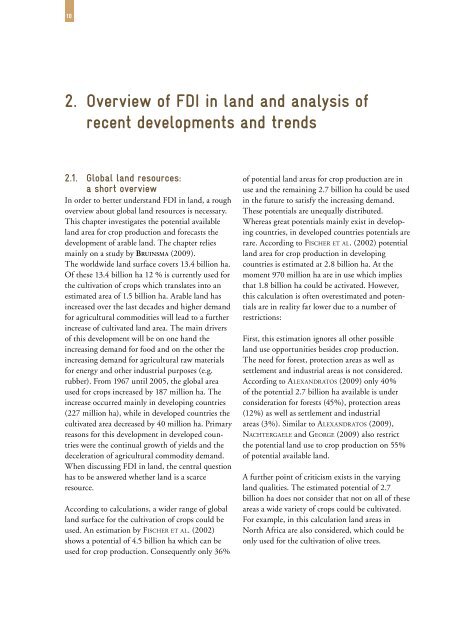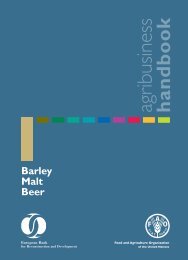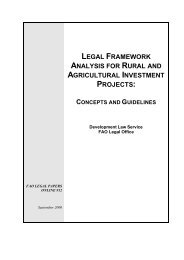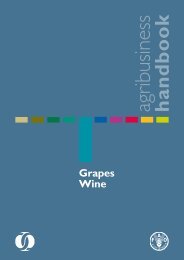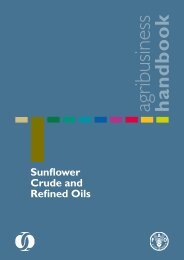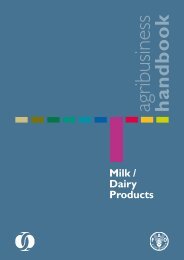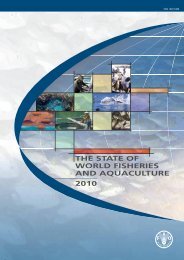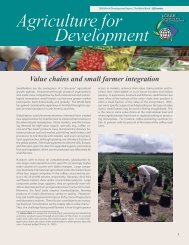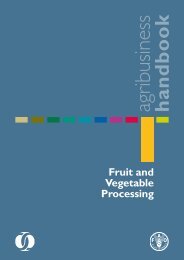Foreign Direct Investment (FDI) in Land in developing countries
Foreign Direct Investment (FDI) in Land in developing countries
Foreign Direct Investment (FDI) in Land in developing countries
- No tags were found...
You also want an ePaper? Increase the reach of your titles
YUMPU automatically turns print PDFs into web optimized ePapers that Google loves.
102. Overview of <strong>FDI</strong> <strong>in</strong> land and analysis ofrecent developments and trends2.1. Global land resources:a short overviewIn order to better understand <strong>FDI</strong> <strong>in</strong> land, a roughoverview about global land resources is necessary.This chapter <strong>in</strong>vestigates the potential availableland area for crop production and forecasts thedevelopment of arable land. The chapter reliesma<strong>in</strong>ly on a study by Bru<strong>in</strong>sma (2009).The worldwide land surface covers 13.4 billion ha.Of these 13.4 billion ha 12 % is currently used forthe cultivation of crops which translates <strong>in</strong>to anestimated area of 1.5 billion ha. Arable land has<strong>in</strong>creased over the last decades and higher demandfor agricultural commodities will lead to a further<strong>in</strong>crease of cultivated land area. The ma<strong>in</strong> driversof this development will be on one hand the<strong>in</strong>creas<strong>in</strong>g demand for food and on the other the<strong>in</strong>creas<strong>in</strong>g demand for agricultural raw materialsfor energy and other <strong>in</strong>dustrial purposes (e.g.rubber). From 1967 until 2005, the global areaused for crops <strong>in</strong>creased by 187 million ha. The<strong>in</strong>crease occurred ma<strong>in</strong>ly <strong>in</strong> develop<strong>in</strong>g <strong>countries</strong>(227 million ha), while <strong>in</strong> developed <strong>countries</strong> thecultivated area decreased by 40 million ha. Primaryreasons for this development <strong>in</strong> developed <strong>countries</strong>were the cont<strong>in</strong>ual growth of yields and thedeceleration of agricultural commodity demand.When discuss<strong>in</strong>g <strong>FDI</strong> <strong>in</strong> land, the central questionhas to be answered whether land is a scarceresource.Accord<strong>in</strong>g to calculations, a wider range of globalland surface for the cultivation of crops could beused. An estimation by Fischer et al. (2002)shows a potential of 4.5 billion ha which can beused for crop production. Consequently only 36%of potential land areas for crop production are <strong>in</strong>use and the rema<strong>in</strong><strong>in</strong>g 2.7 billion ha could be used<strong>in</strong> the future to satisfy the <strong>in</strong>creas<strong>in</strong>g demand.These potentials are unequally distributed.Whereas great potentials ma<strong>in</strong>ly exist <strong>in</strong> develop<strong>in</strong>g<strong>countries</strong>, <strong>in</strong> developed <strong>countries</strong> potentials arerare. Accord<strong>in</strong>g to Fischer et al. (2002) potentialland area for crop production <strong>in</strong> develop<strong>in</strong>g<strong>countries</strong> is estimated at 2.8 billion ha. At themoment 970 million ha are <strong>in</strong> use which impliesthat 1.8 billion ha could be activated. However,this calculation is often overestimated and potentialsare <strong>in</strong> reality far lower due to a number ofrestrictions:First, this estimation ignores all other possibleland use opportunities besides crop production.The need for forest, protection areas as well assettlement and <strong>in</strong>dustrial areas is not considered.Accord<strong>in</strong>g to Alexandratos (2009) only 40%of the potential 2.7 billion ha available is underconsideration for forests (45%), protection areas(12%) as well as settlement and <strong>in</strong>dustrialareas (3%). Similar to Alexandratos (2009),Nachtergaele and George (2009) also restrictthe potential land use to crop production on 55%of potential available land.A further po<strong>in</strong>t of criticism exists <strong>in</strong> the vary<strong>in</strong>gland qualities. The estimated potential of 2.7billion ha does not consider that not on all of theseareas a wide variety of crops could be cultivated.For example, <strong>in</strong> this calculation land areas <strong>in</strong>North Africa are also considered, which could beonly used for the cultivation of olive trees.Rice Harvest


